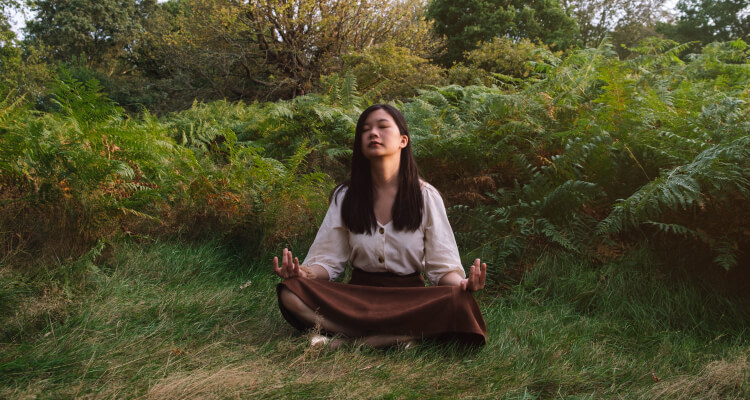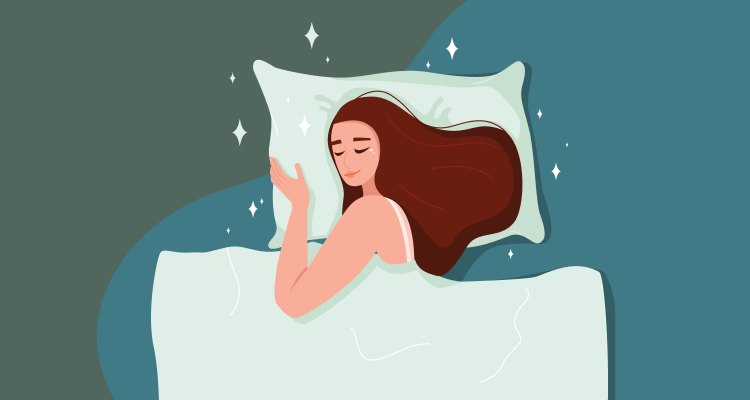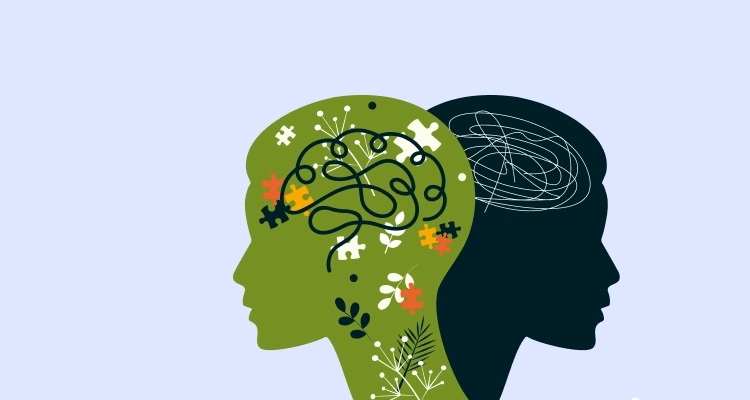Insomnia impacts millions of people globally, making it difficult to fall asleep peacefully. The toll it takes on mental health, focus, and overall well-being is significant. Stress, anxiety, and lifestyle habits often fuel the cycle of sleeplessness, leaving many feeling stuck.
But there’s hope! Yoga provides a comprehensive and evidence-based approach to addressing insomnia. Through gentle poses, calming breathing exercises, and mindful meditation, yoga soothes both the body and mind, helping to lower stress and prepare you for a restful night’s sleep.
What Is Insomnia?
Insomnia is more than just the occasional sleepless night; it’s a complex sleep disorder that can be categorized into two main types: acute and chronic. Acute insomnia lasts for a short period—often triggered by stress, anxiety, or a significant life change—while chronic insomnia persists for at least three nights a week over three months or longer.
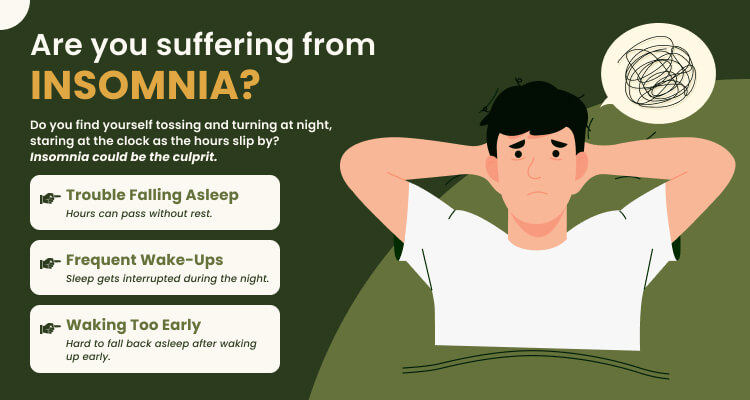
Yoga to the Rescue: How It Helps Manage Insomnia
-
Reduces Stress and Anxiety
In our busy lives, stress often becomes a significant barrier to quality sleep. Stress can leave you feeling restless at night, whether it’s work pressure, personal commitments, or daily anxieties. Yoga offers powerful tools to manage stress and promote relaxation. Through a combination of gentle movements, mindful breathing, and meditation, yoga helps lower cortisol levels—the stress hormone—while activating your body’s natural relaxation response.
Recommended Poses:
Child’s Pose (Balasana): A restorative posture that gently stretches the back, hips, and thighs, encouraging deep relaxation and a sense of surrender. It’s an excellent pose to relieve physical and mental tension.
Cat-Cow Stretch (Marjari asana): A dynamic, flowing movement that relieves tension in the spine and stimulates gentle circulation. It helps release the day’s stress, preparing your body for a peaceful night’s sleep.
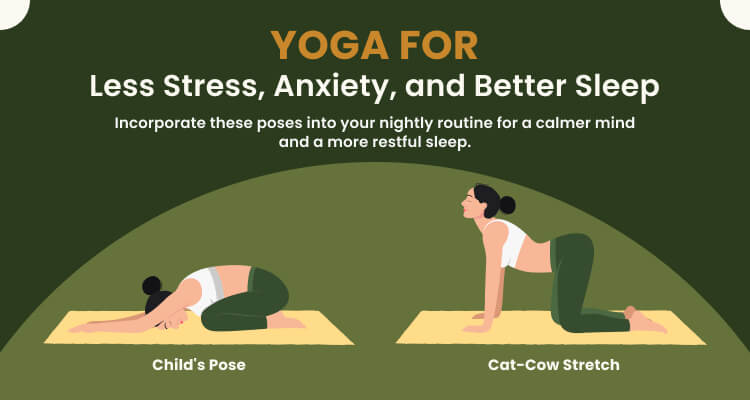
-
Enhances Mind-Body Connection
One of the benefits of yoga is its ability to help you tune into your body. Yoga encourages mindfulness, teaching you to be present and aware of your physical and emotional states. It enables heightened awareness and allows you to recognize tension in your body that you may not even realize you’re holding. As you practice, you learn how to release this tension, creating a calm and relaxed environment more conducive to restful sleep.
A Pro Tip:
Try mindfulness meditation before bed. Focus on your breath and gently redirect your thoughts if your mind wanders. Meditation calms your mind and signals your body it’s time to wind down, leading to more restful sleep.
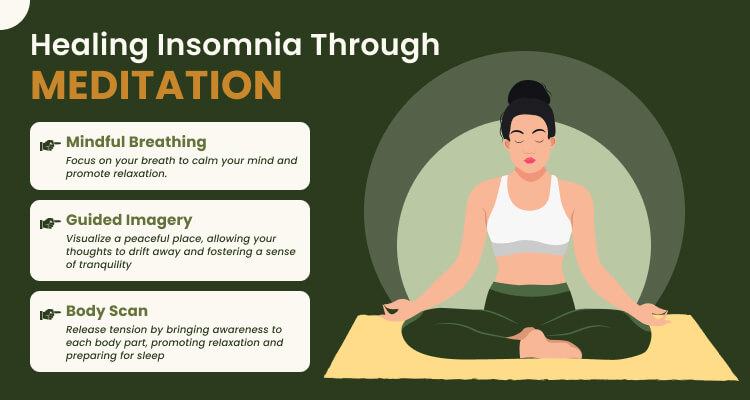
-
Improves Sleep Quality
Countless studies have shown that regular yoga practice can significantly improve sleep quality. By incorporating gentle stretches and restorative poses into your nightly routine, you can ease muscle tension and promote physical relaxation, making it easier to fall asleep and stay asleep throughout the night. Practicing yoga has been found to boost melatonin levels, helping to initiate and maintain better sleep. The calming effects of yoga not only help you unwind but also support deeper, more restorative rest.
Recommended Evening Routine:
To prepare your body for sleep, start with a few gentle stretches to release any tension accumulated during the day. Follow up with restorative poses like Corpse Pose (Shavasana), which promotes deep relaxation by calming the nervous system and allowing your body to unwind before bed. The simple routine can help signal to your mind and body that it’s time for rest.

-
Regulates Sleep Patterns
Consistency is key to good sleep, and yoga can help you establish a steady bedtime routine. By practicing yoga regularly, you can regulate your body’s internal clock, also known as the circadian rhythm, making it easier to fall asleep and wake up at the same time each day.
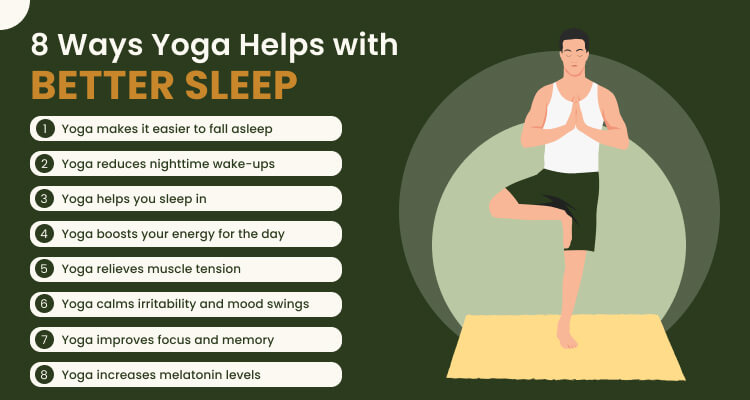
A Pro Tip:
Set aside 15–30 minutes each evening for a gentle yoga practice. Incorporate calming poses and focus on mindful breathing to signal to your body that it’s time to wind down. Think about including a short meditation session to soothe your mind and better prepare yourself for a restful night’s sleep.
The Magic of Breathing Techniques for Better Sleep
Breath control is a vital aspect of yoga that helps regulate the nervous system and foster relaxation:
-
Alternate Nostril Breathing
Alternate Nostril Breathing is a calming breathing technique that balances the nervous system and helps reduce stress, making it easier to fall asleep.
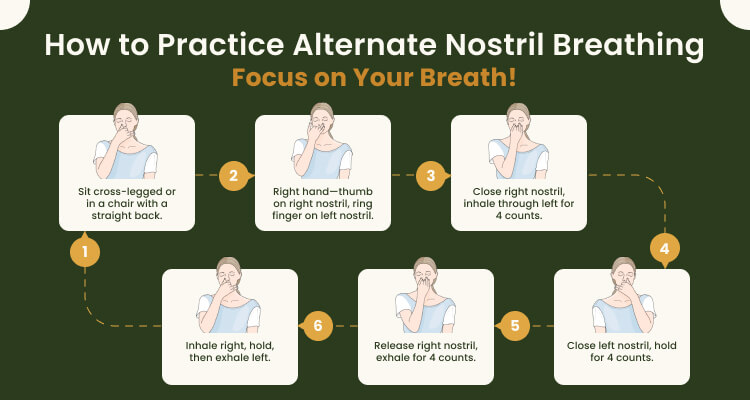
How to Do It?
- Sit comfortably with your spine straight and shoulders relaxed.
- Rest your left hand on your knee.
- Use your right hand to close your right nostril with your thumb, and inhale deeply through your left nostril. Then, close your left nostril with your ring finger, open your right nostril, and exhale slowly.
- Inhale through your right nostril, then close it with your thumb, open your left nostril, and exhale. Repeat for 6 to 8 cycles.
-
Humming Bee Breath (Bhramari)
Humming Bee Breath is a soothing breathing technique that produces a humming sound, providing a tranquilizing effect to your mind and helping to quiet it.
How to Do It?
Sit comfortably, close your eyes, and use your index fingers to gently close your ears. Inhale deeply through your nose. As you exhale, hum like a bee while your mouth remains closed. Notice the vibrations resonating in your head and chest. Repeat for 5-10 breaths, staying focused on the sound and sensation.
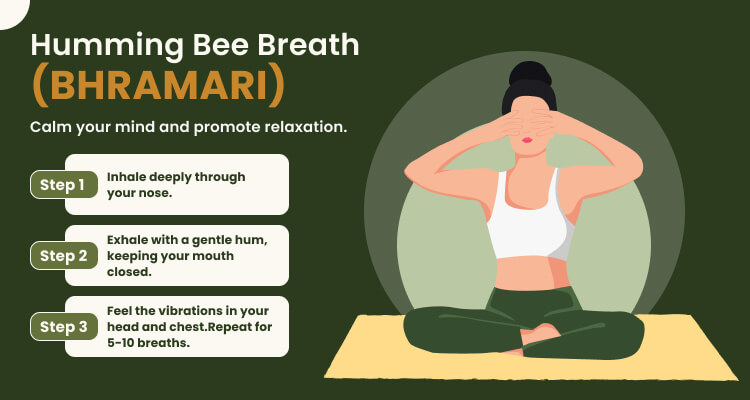
Final Thoughts: Embrace Yoga for Restful Sleep
“Yoga is not about touching your toes; it’s about what you learn on the way down.”
Practicing yoga in your daily routine can be a transformative approach to managing insomnia and enhancing overall well-being. By focusing on specific postures, breathing techniques, and meditation, you can cultivate a serene environment that promotes restful sleep and alleviates the symptoms of insomnia.
At LYBL, we believe in the power of holistic and integrative solutions tailored to your needs. Whether you are looking to improve your sleep quality, manage stress, or embrace a healthier lifestyle, we are here to support you on your journey to wellness.
Explore our resources and join our community to discover how to include yoga and other holistic practices in your life for better sleep and overall health. Together, we can make wellness accessible for all!

